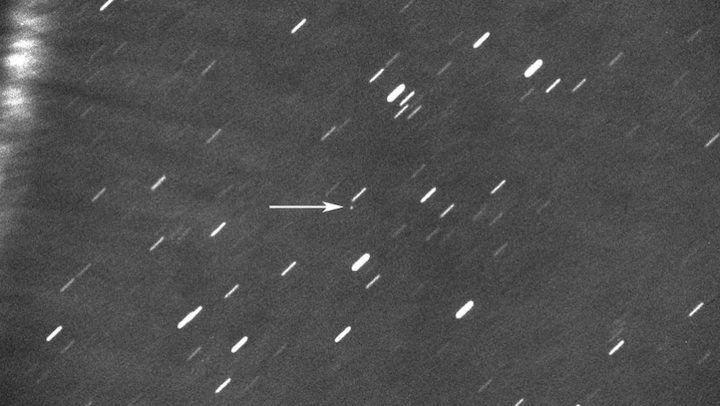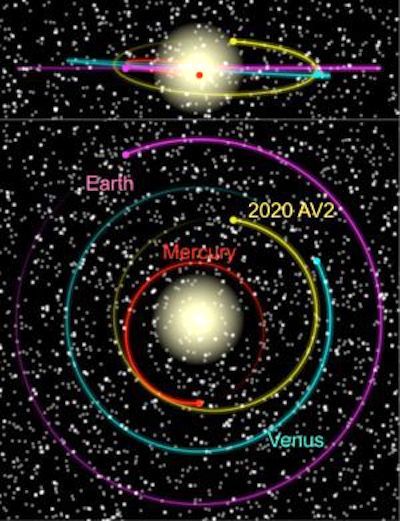22.01.2020

Asteroid 2020 AV2 (arrow), found orbiting closer to the sun than Venus, appears as a white dot in this image from a telescope in Italy that is part of the Virtual Telescope Project.
GIANLUCA MASI/THE VIRTUAL TELESCOPE PROJECT
For the first time, an asteroid has been found orbiting closer to the sun than Venus — a neighborhood where asteroids are thought to be rare and tricky to find.
The space rock, designated 2020 AV2, orbits the sun once every 151 days along an elongated trajectory that keeps it between the orbits of Mercury and Venus. Such asteroids — known as Vatiras — were first predicted in 2012, but until now, no one had ever found one.
Asteroid 2020 AV2 was found January 4 by researchers at the Palomar Observatory in southern California. Following an alert by the International Astronomical Union’s Minor Planet Center, observers around the world confirmed and refined the asteroid’s orbit.
Asteroids that live inside Earth’s orbit are notoriously difficult to find because they spend most of their time close to the sun (SN: 4/3/15). Astronomers can therefore look for such objects only during brief periods of twilight.
According to computer simulations, Vatiras are rare, making up only 0.22 percent of so-called near-Earth objects. Vatiras probably start their lives in the main asteroid belt between Mars and Jupiter and end up between Mercury and Venus after a series of close encounters with rocky planets. Simulations suggest that Vatiras typically don’t remain in orbit around the sun for long — continued gravitational tugs from nearby worlds and uneven solar heating eventually send most crashing into a planet or grazing the sun.
Quelle: ScienceNews
+++
Astronomers find an oddball asteroid entirely inside the orbit of Venus
“Getting past the orbit of Venus must have been challenging.”

Astronomers have found nearly 1 million asteroids in our Solar System, with the vast majority located in the asteroid belt between Mars and Jupiter.
It is far rarer to find asteroids with orbits closer to the Sun, and especially inside the orbit of Earth, due to Jupiter's gravitational influence. There are only about 20 known asteroids with orbits entirely inside that of Earth's. They are called Atira asteroids.
Many of these Atira asteroids have orbits that are substantially tilted away from the plane of the Solar System, suggesting past encounters with Mercury or Venus.
A rare find
Until now, scientists have theorized that Vatira asteroids might exist—those with orbits inside Venus—but had yet to find one. They would be difficult to observe because their orbits would bring them close to the Sun, leaving only a short window to find them in the dusk or dawn sky. And also because presumably they are quite rare due to the gravitational challenge of squeezing into a stable orbit so near the Sun.
But now astronomers have found a Vatira asteroid for the first time. The body, called 2020 AV2, was found earlier this month by the California Institute of Technology's Zwicky Transient Facility, and confirmed by other observatories around the world.
"Getting past the orbit of Venus must have been challenging," said George Helou, a Caltech astronomer and co-investigator at the Zwicky facility, in a news release. "The only way it will ever get out of its orbit is if it gets flung out via a gravitational encounter with Mercury or Venus, but more likely it will end up crashing on one of those two planets."
Astronomers say the asteroid spans about 1 to 3 kilometers in diameter and has an orbit tilted about 15 degrees relative to the plane of the Solar System. During its 151-day elongated orbit, it remains within the path of Venus while also approaching the orbit of Mercury. It likely was thrown into the intervenusian orbit by an encounter with another planet.
The Zwicky camera, attached to a telescope at Palomar Observatory in Southern California, is well suited to finding asteroids because it scans the entire sky rapidly and can observe asteroids during their short-lived appearances in the night sky.
Quelle: arsTechnica
